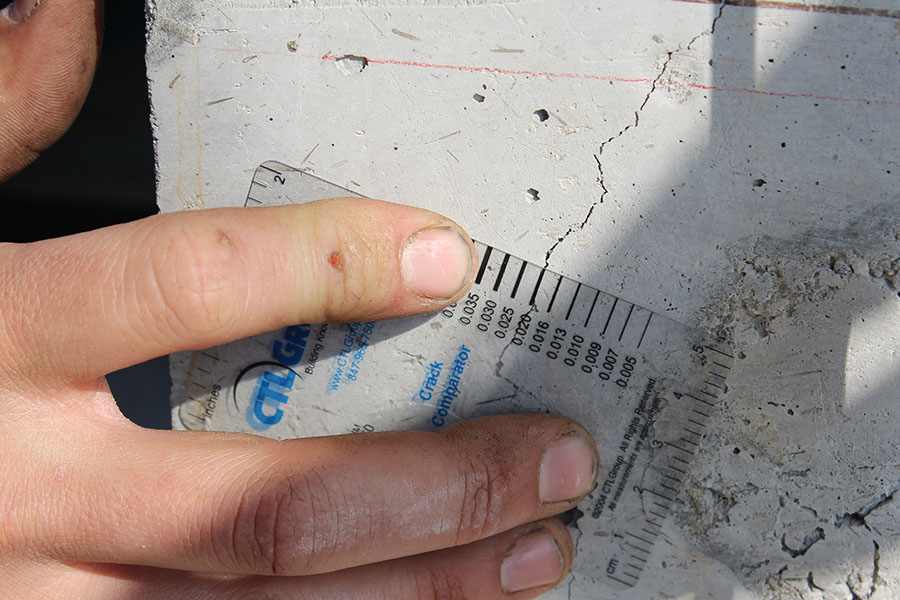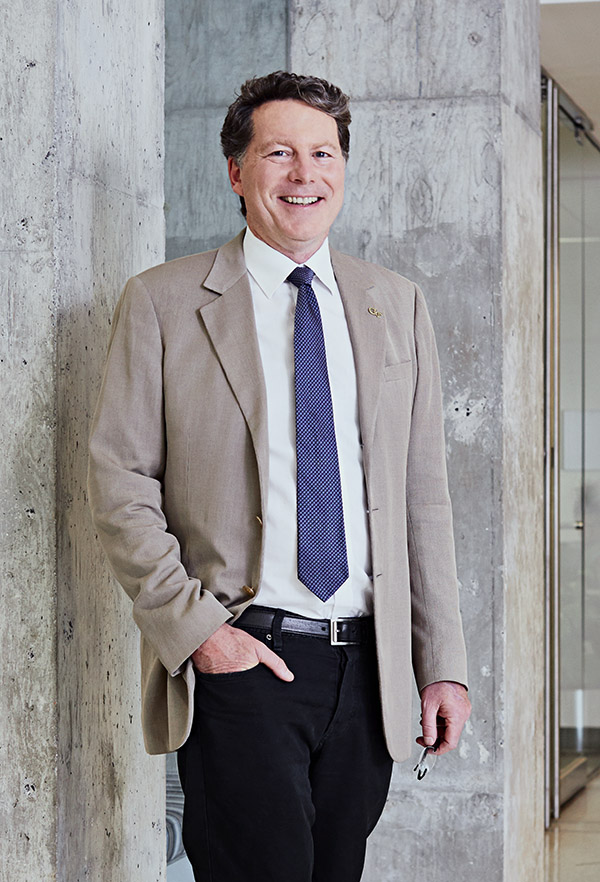 A researcher measures the width of a crack in a reinforced concrete column after testing the strength of the column. A new project funded by the U.S. Department of Energy Advanced Research Projects Agency will develop a field-deployable tool to detect cracks far smaller than this — and inside rather than outside — thick reinforced concrete structures. Finding these microcracks before they become larger cracks will allow for preemptive repairs that vastly improve the concrete's durability and save millions of dollars for owners of power plants, bridges, dams and other larger concrete structures. (Photo: Chris Kiser) |
Imagine giving large concrete structures something similar to an ultrasound and getting images so detailed you can see cracks just a tenth of a millimeter long.
That level of detail just isn’t possible now. Yet such capability could revolutionize how engineers assess the health of thick reinforced concrete infrastructure like dams and power plants and bridges. Repairing those small cracks before they turn into larger ones would vastly improve the durability of those structures and save millions of dollars.
It’s a future that could be just a few years away, thanks to a new project led by the School of Civil and Environmental Engineering’s Laurence Jacobs and Kimberly Kurtis. With almost a million dollars from the U.S. Department of Energy Advanced Research Projects Agency, they’ll develop such an imaging device, using advances in hardware and software and applying deep understanding of how ultrasonic waves interact with concrete.
 Jacobs |
 Kurtis |
“We’re developing a breakthrough tool,” said Jacobs, the lead investigator on the project and a professor of civil engineer and mechanical engineering. “Currently, you cannot do this kind of imaging in concrete — finding and characterizing embedded microscale damage. The high frequency beam needed to image microcracks will attenuate too much in thick concrete components. Plus, concrete is a very complicated material, so it is inherently difficult to get an ultrasonic signal to penetrate.”
The device Jacobs, Kurtis and their collaborators will build tackles both of those obstacles — and, critically, will be used in the field on structures already in service.
First, it will use an array of 64 ultrasound emitters to control the characteristics of the ultrasonic waves — the same kind of technology that makes a CT scan possible. Their device also will manipulate ultrasonic waves in a new way to find small cracks in concrete, breaking through all the different materials in the concrete that typically scatter the waves to see cracks as small as 100 micrometers.
That size is important; it’s the point at which cracks begin to compromise the durability of concrete.
“We are mixing two waves to create a third wave that has certain attributes, then we are imaging the material where those two waves interact. We can scan through the concrete component like that,” he said. “That third wave contains the information that we want about the existence and type of microscale defects.”
Essentially, Jacobs said, the device tricks the ultrasound into creating a high frequency wave inside the concrete.
“Each of the two individual waves cannot [detect micro-cracks] because they are at too low of a frequency for accurate imagining,” he said. “You need a high frequency to image microscale damage, yet a high frequency beam will attenuate too much.”
Similar imaging systems for metal components have been developed over the last 15 years or so and saved hundreds of millions of dollars in repair costs by allowing for accurate damage assessments and maintenance decisions, Jacobs said. Developing the technology for concrete presents the same potential: detecting and fixing microcracks would make concrete far more durable.
“This technology could potentially revolutionize the concrete industry,” the team wrote in their proposal. “If microcracks can be detected early, repairs can be made to avoid the growth of these microcracks into macrocracks.”
The project is one of a handful funded this month by what’s known as ARPA-E as part of a program to develop extremely durable concretes and cementitious materials. The agency was looking for high-risk, unconventional ideas that could lead to disruptive technologies.
Once the team proves their device works, they will tap Georgia Tech’s Venture Lab and Advanced Technology Development Center to develop commercialization strategies and make their array available to the nondestructive evaluation industry.
“That is critical for ARPA-E. We will be spending a lot of time and effort on creating a system that’s useful for industry and taking it to market,” Jacobs said.
Jacobs and Kurtis will work with Georgia Tech’s Jin-Yeon Kim and Jianmin Qu at Tufts University on the two-year project.
It will be a particularly busy time for Kurtis, who’s part of the research team for three of the newly funded ARPA-E projects. A project with the University of Michigan will develop “extremely durable concrete” with built-in crack-width control that’s resistant to chemical attacks. Another with Carnegie Mellon University will cut the energy needed to produce concrete in half by using machine learning to design new binding agents for concrete mixtures.
“ARPA-E is like a venture fund embedded in the Department of Energy, meaning that they seek to invest in riskier, but high-reward ideas,” Kurtis said. “I’m excited to be part of innovative research that can truly transform the way cements and concretes are produced and infrastructure constructed, making real, positive environmental impact.”
Related

